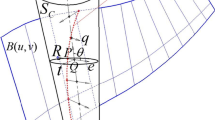Abstract
Current CAM and milling verification software packages are not ready to predict form and surface errors derived from non-ideal conditions such as runout tool error or tool–workpiece flexibility. As a consequence, high-end parts like integral blade rotors (IBR) suffer from this lack of estimation to achieve a sound manufacturing process preparation. This work describes the implementation of a cutting force prediction model that introduces the radial engagement reduction caused by (i) tool runout and (ii) workpiece flexibility. The model is used as the seed for a calculation module based on solid modeling to obtain the surface roughness and topography applying the cutting force–wall restitution equilibrium, making use of the power of CAM solid modelers for the final topography definition. This idea takes advantage of the good accuracy of current solid modelers in comparison with the z-map topographical approach for obtaining the cutter–workpiece engagement (CWE) at each tool path step. Several flank milling tests were carried out to validate the simulations. The results demonstrated a significant level of accuracy to predict shape errors. The model may be integrated in a CAM procedure, and it is a useful utility for reducing deformation on the manufacturing of blisks and impellers.
Similar content being viewed by others
References
Bouzakis KD, Aichouh P, Efstathiou K (2003) Determination of the chip geometry, cutting force and roughness in free form surfaces finishing milling, with ball end tools. International Journal of Machine Tools & Manufacture 43:499–514
Arizmendi M, Fernández J, López de Lacalle LN, Lamikiz A, Gil A, Sánchez JA, Campa FJ, Veiga F (2008) Model development for the prediction of surface topography generated by ball-end mills taking into account the tool parallel axis offset. Experimental validation. CIRP Annals – Manufacturing Technology 57:101–104
Bao WY, Tansel IN (2000) Modeling micro-end-milling operations. Part II: tool run-out. International Journal of Machine Tools & Manufacture 40:2175–2192
Arizmendi M, Fernández J, Gil A, Veiga F (2009) Effect of tool setting error on the topography of surfaces machined by peripheral milling. International Journal of Machine Tools & Manufacture 49:36–52
Arizmendi M, Campa FJ, Fernández J, López de Lacalle LN, Gil A, Bilbao E, Veiga F, Lamikiz A (2009) Model for surface topography prediction in peripheral milling considering tool vibration. CIRP Ann Manuf Technol 58:93–96
Jiang H, Long X, Meng G (2008) Study of the correlation between surface generation and cutting vibrations in peripheral milling. J Mater Process Technol 208:229–238
Costes JP (2013) A predictive surface profile model for turning based on spectral analysis. J Mater Process Technol 213:94–100
Omar OEEK, El-Wardany T, Ng E, Elbestawi MA (2007) An improved cutting force and surface topography prediction model in end milling. International Journal of Machine Tools & Manufacture 47:1263–1275
Denkena B, Küger M, Bachrathy D, Stepan G (2012) Model based reconstruction of milled surface topography from measured cutting forces. International Journal of Machine Tools & Manufacture 54-55:25–33
Yang D, Küger Z, Bachrathy D, Stepan G (2015) Surface plastic deformation and surface topography prediction in peripheral milling with variable pitch end mill. International Journal of Machine Tools & Manufacture 91:43–53
Kline A, DeVor R, Shareef I (1982) The prediction of surface accuracy in end milling. ASME Journal of Engineering for Industry 104:272–278
Budak E, Altintas Y (1995) Modeling and avoidance of static form errors in peripheral milling of plates. International Journal of Machine Tools & Manufacture 35:459–476
Ratchev S, Nikov S, Moualek I (2004) Material removal simulation of peripheral milling of thin wall low-rigidity structures using FEA. Adv Eng Softw 35:481–491
Biermann D, Kersting P, Surmann T (2010) A general approach to simulating workpiece vibrations during five-axis milling of turbine blades. CIRP Ann Manuf Technol 59:125–128
Quinsat Y, Sabourin L, Lartigue C (2008) Surface topography in ball end milling process: description of a 3D surface roughness parameter. J Mater Process Technol 195:135–143
Lavernhe S, Quinsat Y, Lartigue C (2010) Model for the prediction of 3D surface topography in 5-axis milling. Int J Adv Manuf Technol 51:915–924
Surmann T, Enk D (2007) Simulation of milling tool vibration trajectories along changing engagement conditions. International Journal of Machine Tools & Manufacture 47:1442–1448
Surmann T, Biermann D (2008) The effect of tool vibrations on the flank surface created by peripheral milling. CIRP Ann Manuf Technol 57:375–378
E. Aras, Cutter-workpiece engagement identification in multi-axis milling. Dissertation, The University of British Columbia, Vancouver (2008).
Yang Y, Zhang WH, Wan M, Ma YC (2013) A solid trimming method to extract cutter-workpiece engagement maps for multi-axis milling. Int J Adv Manuf Technol 68:2801–2813
Lazoglu I, Boz Y, Erdim H (2011) Five-axis milling mechanics for complex free form surfaces. CIRP Ann Manuf Technol 60(1):117–120
Y. Altintas, Manufacturing automation: metal cutting mechanics, machine tool vibrations, and CNC design. Cambridge University Press (2000), ISBN 10: 0521659736
Engin S, Altintas Y (2001) Mechanics and dynamics of general milling cutters. Part I: helical end mills. International Journal of Machine Tools & Manufacture 41:2195–2212
Gradisek J, Kalveram M, Weinert K (2004) Mechanistic identification of specific force coefficients for a general end mill. International Journal of Machine Tools & Manufacture 44:401–414
D. Olvera, A. Calleja, L. N. López de Lacalle, F. Campa, A. Lamikiz, Flank milling of complex surfaces. In: Machining of complex sculptured surfaces. Springer (2012), ISBN 978–1–4471-2355-2
Campa FJ, López de Lacalle LN, Celaya A (2011) Chatter avoidance in the milling of thin floors with bull-nose end mills: model and stability diagrams. Int J Mach Tools Manuf 51(1):43–53
W.C. Young, R.G. Budynas, Roark’s formulas for stress and strain. McGraw Hill Seventh edition (1989) 189, ISBN-10: 0071742476
Author information
Authors and Affiliations
Corresponding author
Rights and permissions
About this article
Cite this article
Artetxe, E., Olvera, D., de Lacalle, L.N.L. et al. Solid subtraction model for the surface topography prediction in flank milling of thin-walled integral blade rotors (IBRs). Int J Adv Manuf Technol 90, 741–752 (2017). https://doi.org/10.1007/s00170-016-9435-1
Received:
Accepted:
Published:
Issue Date:
DOI: https://doi.org/10.1007/s00170-016-9435-1




